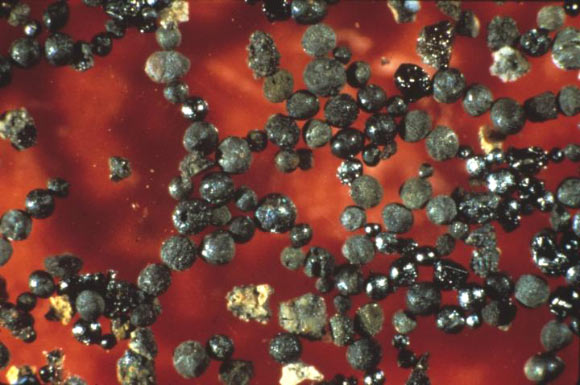A team of researchers from the University of Washington and NASA’s Ames Research Center has analyzed iron-rich micrometeorites collected from 2.7 billion-year-old (Archean Eon) limestone in the Pilbara region of Western Australia and found that these tiny space rocks encountered a carbon dioxide-rich atmosphere on their journey to the planet’s surface.

These 2.7 billion-year-old meteorites, about half a millimeter across, fell into the ocean and were collected from the deep sea. Image credit: Donald Brownlee / University of Washington.
“Life formed more than 3.8 billion years ago, and how life formed is a big, open question,” said Owen Lehmer, a doctoral student in the Department of Earth and Space Sciences at the University of Washington and the Space Science Division at NASA’s Ames Research Center.
“One of the most important aspects is what the atmosphere was made up of — what was available and what the climate was like.”
In the study, Lehmer and colleagues took a fresh look at interpreting how Archean iron-rich micrometeorites interacted with the atmosphere.
The sand-sized grains hurtled toward Earth at up to 20 km/s (45,000 mph).
For an atmosphere of similar thickness to today, the metal beads would melt at about 80 km (50 miles) elevation, and the molten outer layer of iron would then oxidize when exposed to the atmosphere.
A few seconds later the micrometeorites would harden again for the rest of their fall. The samples would then remain intact, especially when protected under layers of sedimentary limestone rock.
In a previous study, researchers interpreted the oxidization on the surface as a sign that the molten iron had encountered molecular oxygen.
The new study uses modeling to ask whether carbon dioxide could have provided the oxygen to produce the same result.
A computer simulation found that an atmosphere made up of from 6% to more than 70% carbon dioxide could have produced the effect seen in the samples.
“The amount of oxidation in the ancient micrometeorites suggests that the early atmosphere was very rich in carbon dioxide,” said Professor David Catling, also from the Department of Earth and Space Sciences at the University of Washington.
For comparison, carbon dioxide concentrations today are rising and are currently at about 415 parts per million, or 0.0415% of the atmosphere’s composition.
High levels of carbon dioxide, a heat-trapping greenhouse gas, would counteract the Sun’s weaker output during the Archean Eon.
Knowing the exact concentration of carbon dioxide in the atmosphere could help pinpoint air temperature and acidity of the oceans during that time.
“More of the ancient micrometeorite samples could help narrow the range of possible carbon dioxide concentrations,” the scientists said.
Grains that fell at other times could also help trace the history of Earth’s atmosphere through time.
“Because these iron-rich micrometeorites can oxidize when they are exposed to carbon dioxide or oxygen, and given that these tiny grains presumably are preserved throughout Earth’s history, they could provide a very interesting proxy for the history of atmospheric composition,” Lehmer said.
The results were published in the journal Science Advances.
_____
O.R. Lehmer et al. 2020. Atmospheric CO2 levels from 2.7 billion years ago inferred from micrometeorite oxidation. Science Advances 6 (4): eaay4644; doi: 10.1126/sciadv.aay4644







